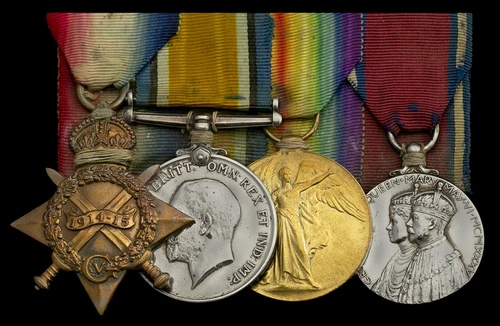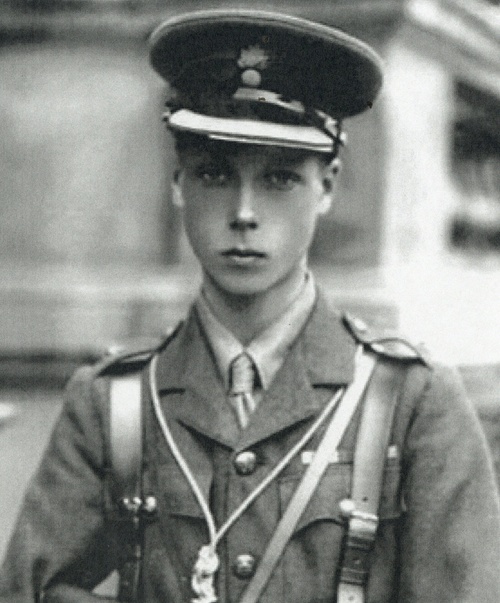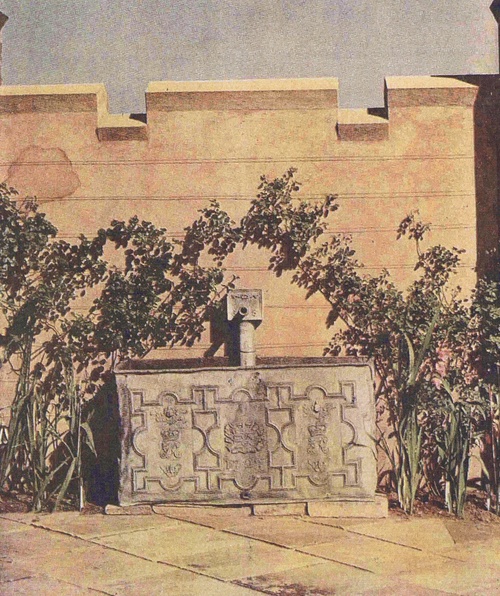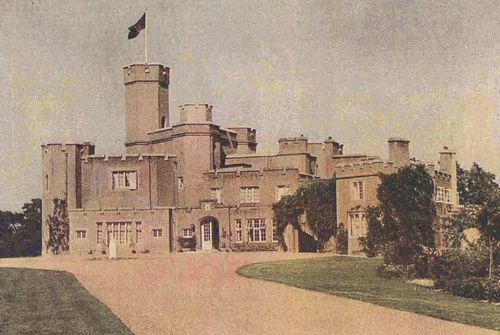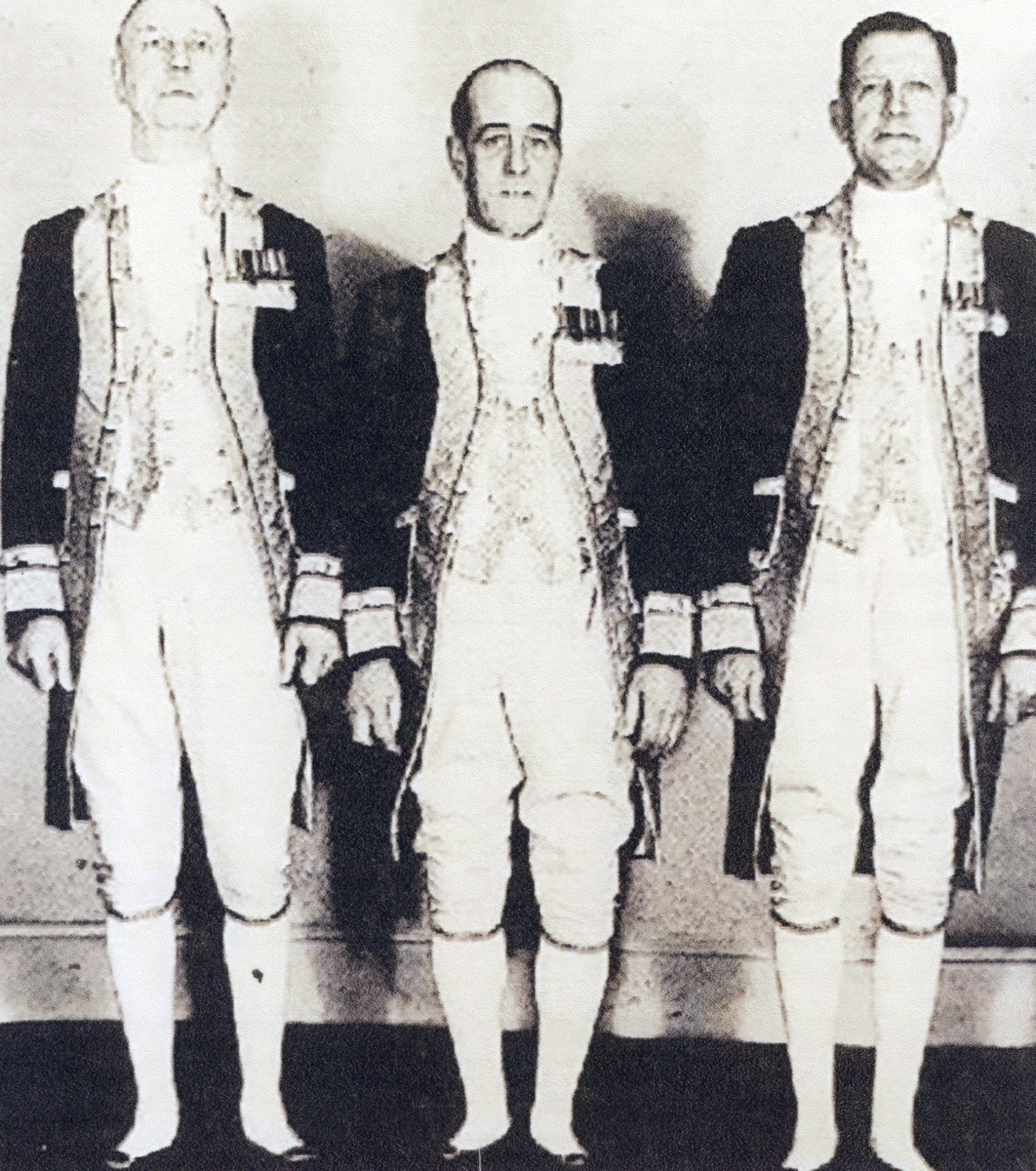Auction: 18003 - Orders, Decorations and Medals
Lot: 386
The emotive - and important - 'Royal Service' group of four awarded to Leonard Osborn, late Grenadier Guards
Appointed batman to the Prince of Wales - the future Edward VIII - during the Great War, Osborn accompanied Edward in Paris during his scandalous affair with Marguerite Alibert, a prostitute subsequently charged with murdering her husband in the Savoy Hotel
Osborn served later as Edward VIII's butler at Fort Belvedere throughout the Abdication Crisis, where he was victimised and humiliated by American divorcee Wallis Simpson; among other tasks, the King's mistress delegated flower arranging duties to the ex-Guardsman
The lurid events which took place at Fort Belvedere - as recently portrayed in the hugely popular Netflix series 'The Crown' - were witnessed first-hand by Osborn; they - or 'what the butler saw' - offer a unique insight into this tense period of British history
1914-15 Star (21396 Pte. L. Osborne. G. Gds:); British War and Victory Medals (21396 Pte. L. Osborn G. Gds.); Jubilee 1935, mounted as worn, good very fine or better (4)
Leonard Osborn was born in May 1894 at Harringworth Lodge, Kettering, Northamptonshire, the fourth son of Thomas Osborn, Head Gamekeeper on the Bulwick Park estate. Employed as a Footman at Bulwick, he enlisted into the 5th (Reserve) Battalion, Grenadier Guards at Cockspur Street, London on 29 December 1914.
Osborn transferred to the 3rd Battalion, Grenadier Guards on 18 August 1915. Part of the 2nd Guards Brigade, the Battalion arrived in France on 27 July and took part in the battle of Loos in September. The Battalion captured the third-line German trenches, defending this advanced position for two days before relief came; German counter-attacks caused 229 casualties. During the 1916 Somme Offensive the 3rd Battalion held trenches in the Beaumont-Hamel sector from 13 August. It joined the attack on Lesbœufs on 15 September, suffering heavy losses before the first objective was reached. The Battalion's casualties in this action totalled 412.
Royal batman - Royal scandal
Edward, Prince of Wales, joined the Grenadiers as a 2nd Lieutenant in June 1914. Having reached the minimum age for active service, he agitated to serve in France with the 1st Battalion, reasoning that with four brothers to take his place he was expendable. Kitchener intervened, anxious over what might happen if the heir to the throne were captured (Ziegler 1990, 51). Edward was nevertheless appointed to the staff of Field-Marshal Sir John French at B.E.F. Headquarters, which he found 'pretty dull and monotonous' (see Windsor 1951). In mid-1916 he was awarded the M.C., despite never seeing action. Visiting the Grenadiers to raise morale, he sampled army rations and inspected the deployment of Livens Projectors. From April 1917 he overcame his disappointment at not being allowed to fight by starting an 18-month dalliance with Marguerite Alibert, the high-class Parisian prostitute. Osborn, a fellow Grenadier, became Prince Edward's batman in 1917 as this scandalous affair was unfolding.
Alibert worked in a Parisian brothel known as the Maison de Rendezvous, first beguiling Edward at the Hôtel de Crillon. The Prince became infatuated, exchanging recklessly indiscreet letters. Lord Curzon told his wife he was 'terribly afraid about what would happen' (Holman 2013); Osborn must have seen everything. Curzon's fears were justified in September 1923, when Alibert stood trial at the Old Bailey for murdering Prince Ali Fahmy, her Egyptian husband. She stood accused of shooting him three times in the back with a Browning .32 calibre semi-automatic pistol while staying at the Savoy Hotel. Alibert had married Fahmy in 1921, after Edward lost interest in her, Edward for his own part pursuing Freda Dudley Ward, wife of the Rt. Hon. William Dudley Ward, Liberal M.P. for Southampton. The Royal Household soon identified the defendant as Edward's former lover. Edward's staff made arrangements for his incriminating love letters to be retrieved, Major Ernest Bald visiting Alibert in her Holloway cell to negotiate the handover. After painstakingly checking each letter's authenticity, Edward had them destroyed.
Despite conclusive evidence to prove her guilt, Alibert was acquitted. She had as her defence lawyer one of the finest barristers of the age, Sir Edward Marshal Hall, and before the trial started the judge ruled that no evidence relating to Alibert's life prior to 1921 should be mentioned. Who was the main beneficiary of this ruling? Edward had everything to lose if his indiscretions became public knowledge, so the British establishment closed ranks to save his reputation. Osborn and the Royal Household withheld their stories from the Press, displaying intense loyalty to Edward.
'Ambassador of Empire' - The arrival of Wallis Simpson
Edward made sixteen tours of the Empire between 1919 and 1935, including an extensive visit to India and Japan in 1921-22. General Sir Reginald Wingate called him 'The Ambassador of Empire', and he was rapturously welcomed in Canada and Australia. His liaison with Dudley Ward continued, however, radically altering his public image. Whereas in 1919 society ladies had gushed about the Prince as a 'charming boy', now the Press called him 'a gay young man'. When he sailed to New York aboard the Berengaria in 1924, Edward feared that American journalists would portray him as a 'reckless libertine' (Ziegler 1990, 150). Dismayed with his eldest son's behaviour and disgusted by his penchant for married women, King George V was heard to exclaim: 'After I am dead, the boy will ruin himself in twelve months' (Barnes 1969, 976).
Osborn remained in the Prince's service throughout the inter-war years, rising to become his butler at Fort Belvedere. Situated at the southern tip of Windsor Great Park, this neo-Gothic 18th century mansion became Edward's country seat in 1930. Its interiors were the brainchild of George IV, Edward carrying out extensive refurbishments. He chose it deliberately as his own 'castle', from which he could defy his family over in Windsor Castle. Belvedere was to be the setting for some of the most dramatic scenes of Edward's life.
One of the married women whom Edward pursued, Lady Furness, introduced him to an American friend of hers called Wallis Simpson. Simpson had divorced her first husband, a U.S. naval officer called Win Spencer, in 1927. When she met Edward she was married to Ernest Simpson, a British-American shipbroker who served in the Coldstream Guards during the Great War. Edward and Wallis became lovers while Lady Furness was travelling abroad, although Edward vehemently denied to his father that Wallis was his 'mistress'. In 1935 George V and Queen Mary denied her access to Buckingham Palace. Officers from Special Branch, Metropolitan Police spied on the pair wherever they went, particularly when Hitler received them warmly at the Berghof.
Humiliated butler
Wallis asserted her power in the summer of 1934, seizing control at Fort Belvedere. She ordered the switchboard operator never to put Freda Dudley Ward through to the Prince of Wales. She then upended centuries of traditions and privileges among the household staff. As butler, Osborn was responsible for setting the household's rules and delegating duties among lower-level staff, right down to the kitchen and cellars. Higham writes that Osborn considered his position 'unassailable, absolute and final', and 'took orders only from royalty' (Higham 2005, 133). It must have been a shock to Osborn when, after years of loyal service, Edward informed him that he was to take orders from an American commoner and divorcee. Wallis humiliated Osborn by instructing him to undertake the flower arrangements, an unmasculine task normally delegated to maids (see 'The Crown', Series 2). She set the menus for each day of the week, despite only being present at the Fort on weekends. This had always been Osborn's prerogative. Worst of all, she completely redecorated the fort, pulling up carpets, ripping down curtains and putting Regency furniture into storage.
Osborn informed Ulick Alexander, Edward's equerry, that he was very unhappy. Alexander recalled: 'Mrs S had got her knife into him, and he felt that he was doomed. O. said that things were very unsatisfactory, and that after a night at the Fort with Mrs S the King was absolutely limp and a rag' (quoted in Ziegler 1990, 280). Her talents, acquired in the alleys of Shanghai, had clearly borne fruit. Osborn picked up a label in Mrs. Simpson's writing which had evidently been attached to some present given to the King. It read: 'To our marriage'.
When Edward became King on 20 January 1936, the Government did not permit him to marry Wallis Simpson without renouncing the throne. In a public broadcast, he told the Empire that he could not rule without the woman he loved by his side. At Fort Belvedere, during the night of 10 December, Edward's 'Instrument of Abdication' was signed in the presence of all Edward's brothers. Given the titles 'Duke and Duchess of Windsor', Edward and Wallis were sent to live in Bermuda. Fearing that the Nazis might use Edward as a puppet king, Churchill ordered a Royal Marine to permanently shadow the Duke and shoot him if ever the Nazis seized power.
Wallis left Fort Belvedere, never to return, on 6 December 1936. She stormed through the King's bedroom and across the lawn without saying goodbye to any of the staff. Alfred Amos, one of the Footmen, recalled saying to Osborn: 'Well, that's the end of that.' Osborn's reply was: 'Don't be so sure. We'll keep our fingers crossed.' (Higham 2005, 310).
After Wallis
Following the Abdication Osborn remained in England with the Royal Household, his brother Victor becoming valet to King George VI. The 1939 Census records him living at 1 Palace Garden Mews, working in George VI's household as a 'butler and domestic servant'.
Osborn married Daisy Smith, of Chipping Norton, in September 1926. After retiring from royal service he moved to 10 Niagara Avenue, Ealing. He worked in hotels as a concierge for many years, and died on 31 August 1966, aged 73; sold with a file of copied research.
Reference works:
Barnes, J., Baldwin: A Biography (London, 1969).
Hanning, H., The British Grenadiers (London, 2006).
Higham, C., The Duchess of Windsor: The Secret Life, 2nd Edition (Hoboken, 2005).
Holman, J., 'Wallis Simpson wasn't the first mistress to threaten Edward VIII's reputation,' The Express, 6 April 2013.
Rose, A., The Prince, The Princess and The Perfect Murder: An Untold Story (London, 2013).
Rose, A., Scandal at the Savoy: The Infamous 1920s Murder Case (London, 1991).
Wilson, B., 'Edward VIII's Murderous Mistress: Was there a cover-up of Edward VIII's fling with a murderess?', The Telegraph, 21 April 2013.
Windsor, The Duke of, A King's Story (London, 1951).
Ziegler, P., King Edward VIII (London, 1990).
http://www.channel4.com/info/press/programme-information/edward-viiis-murderous-mistress
Subject to 20% VAT on Buyer’s Premium. For more information please view Terms and Conditions for Buyers.
Sold for
£1,000

